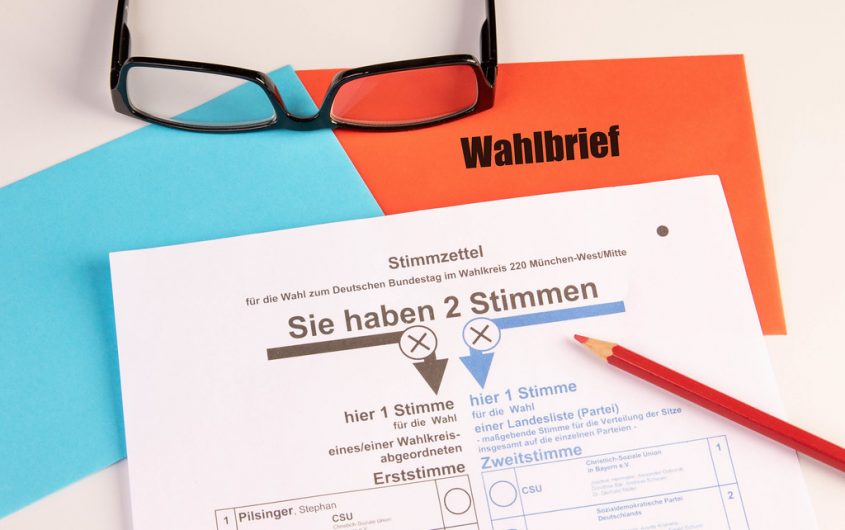
via Marco Verch
He Votes, She Votes

Ansgar Hudde
University of Cologne
Ansgar Hudde is a sociologist at the University of Cologne. He completed his doctorate at the University of Bamberg and was a visiting researcher at institutions including Nuffield College at the University of Oxford and Sciences Po Paris. His research focuses on family and partnership, sustainability and mobility behavior, as well as political attitudes and their role for personal relationships.
The Evolution of Gendered Voting in Germany
The German federal election of 2017 brought up a novelty: for the first time, women were voting more left-wing than men. When I tell my colleagues and friends about this “modern gender gap” in party choice, it does not spark much surprise. After all, current gendered voting patterns mainly align with the parties’ stance on gender-equity topics and feminism, especially among the youngest voters. The parties that are most vocal in their call for public interventions for more gender equity have more women in their electorate.[1]
Some of those friends and colleagues are, however, surprised that this pattern is new and that it was the opposite for many decades. Across Western democracies and over several decades—in Germany until the 1970s—women were voting more for conservative parties and less for left-wing parties than men. This implies that women were less likely to vote for the parties that were the most progressive on gender equity topics. As early as 1927, eight years after the first election with women’s suffrage, the then-director of the German statistical office summarized that women’s right to vote “harmed the parties that demanded it but benefited those that rejected it.”[2]
During the Weimar Republic and the post-World War II period until the late 1970s, women were leaning more toward the conservative Christian Democrats, men more toward the Social Democrats. Starting in the 1980s, gender differences in voting behavior were generally small. With the new millennium, when the fractionalization of the German party system accelerated, gender differences emerged but they did not yet align with the left-right political spectrum. Today, among the youngest voters, the gendered patterns almost completely follow the left-right spectrum, where the more left-wing the party is, the higher the percentage of their electorate becomes female. While this is only a brief and simplified summary, you can learn more about the trends in my published study.
Similar trends toward a “modern gender gap” of women being more left-wing than men have been reported for several Western societies.[3] What is unique about Germany is data quality to trace such trends. For other countries, researchers have to rely on surveys, which come with issues like small samples or social desirability bias: in particular, some of those who vote far-right do not admit to it on the phone. For Germany, we do not have to rely on surveys but have information from ballots and actual voting behavior. For this globally unique data source, a sample of ballot papers, about 1.9 million in 2021, prints the voters’ gender and age group. Results are then published by demographic groups, which is a globally unique data source for gendered voting patterns for its reliability and precision.
What factors can explain the shift toward the modern gender gap in Germany and beyond? One of the factors is the long-term decline in religiosity. Women’s historic adherence to conservative and Christian Democratic parties was often explained by their on average higher levels of religiosity. With a general trend towards secularism, this attachment has declined, and the effect is stronger for women than men, because their decrease in religiosity started from a higher level. Further and as part of a broader move toward more gender equality, women’s employment rates have increased dramatically, which might motivate them to prioritize job-related considerations over religious motivations. With women being overrepresented in lower-paying jobs and shouldering the majority of care work in the family, they might have an incentive to favor parties that stand for economic redistribution and public work-family-reconciliation policies. Finally, over recent decades, electoral competition has moved away from ‘classical’ economic issues and toward socio-cultural issues, which include gender equity. Even though gender equity has increased across the last decades, remaining inequities and parties’ different positions on this might have become more salient and decisive for vote choice.
Beyond these societal long-term trends, the party-political offer matters. Germany was a “latecomer” in terms of a new populist, radical-right party. Whereas comparable parties have existed in countries like Switzerland, France, or the Netherlands for decades, the Alternative for Germany (AfD) was only founded in 2013 and shifted to its current radical-right positioning around 2015. In most countries, such radical-right parties are more popular among men—at least during the earlier phases of these parties’ emergence. One can only speculate about a situation where the AfD had emerged earlier. If so, would the modern gender gap have emerged earlier in Germany as well?
Looking ahead
As an observer and researcher interested in gendered voting patterns, here are two things I will be looking out for in the upcoming elections for the European Parliament in June 2024 and regional elections in September 2024.
First, Among young voters in 2021, the gender gap was mainly between the Greens and the Free Democrats (FDP). In this group, 26 percent of men voted FDP compared to 15 percent of women. Since then, the FDP has declined sharply in national polls. How will this change mirror among young men, the most FDP-leaning group in the last election? Which other party will they most often switch to, Green, Conservative, or hard right?
Second, considering the gender gap among the radical-right AfD—in the last federal election, 14.1 percent of men voted for that party, compared to 8.6 percent of women—the regional elections in the three eastern federal states of Brandenburg, Thuringia, and Saxony later this year will give important insight. The gender gap among the radical right generally seems to be smallest or absent in places where those parties have achieved relatively high levels of normalization.[4] This means that where such parties are more established and less socially stigmatized, their voter support expands among broader demographic groups, including women. [5] Internationally, survey data suggest that this is the case in France, Italy, and the Netherlands. Within Germany, the upcoming elections in Saxony and Thuringia will be a strong test case for this idea. In these states, the AfD shows the strongest signs of normalization.
The gender gap among the radical right generally seems to be smallest or absent in places where those parties have achieved relatively high levels of normalization… The upcoming elections in Saxony and Thuringia will be a strong test case for this idea.
To be clear, I do not mean ‘normalization’ in terms of the party’s political orientation and positions. As the political scientist Kai Arzheimer puts it: “the radicalisation and normalisation of Alternative for Germany [AfD] seem to happen in tandem.” Indeed, the regional party branches in Saxony and Thuringia have the reputation of being particularly radical, but it is in these regions that the party was strongest in 2021 and where it is currently polling above 30 percent.
Normalization thereby means that the voting for this party becomes less stigmatized and more socially accepted. Beyond previous and expected electoral success, another indicator suggests normalization: a decrease in the rejection of the AfD among people who do not vote for them, including voters of left-wing parties. Politbarometer regularly polls what feelings people have toward all parties, ranging from very cold (negative) to very warm (positive). On average across western Germany, 79 percent chose the most negative category for the AfD, compared to ‘only’ 67 percent in Saxony and Thuringia.[6] Overall, there is a strong correlation across space and across time: the stronger the party is overall, the more its rejection diminishes.
With the relatively high level of normalization of the AfD in many eastern states, their electorates might become more demographically balanced and include more women. Already in the federal election of 2021, the gender gap in AfD voting was weaker in Saxony and Thuringia than in all other regions. The 2024 elections might bring the most gender-balanced AfD-electorate so far, and the next Bundestag election is only eighteen months away.
[1] Information on parties’ issue positions come from the Open Expert Survey.
Michael Jankowski, Anna-Sophie Kurella, Christian Stecker, Andreas Blätte, Thomas Bräuninger, Marc Debus, Jochen Müller, & Susanne Pickel, “Die Positionen der Parteien zur Bundestagswahl 2021: Ergebnisse des Open Expert Surveys,” Politische Vierteljahresschrift 63, no. 1 (2022), p. 53–72. doi:10.1007/s11615-022-00378-7.
The gender-specific items can be found in their codebook: https://dataverse.harvard.edu/file.xhtml?fileId=5194839&version=1.0.
[2] Lübeck Hartwig, “Wie die Frauen im Deutschen Reich von ihrem politischen Wahlrecht Gebrauch machen,” In Niederschrift der … Mitgliederversammlung der Deutschen Statistischen Gesellschaft (Deutsche statistische Gesellschaft, 1927), p. 510.
[3] See for instance: Ruth Dassonneville, “Change and continuity in the ideological gender gap a longitudinal analysis of left-right self-placement in OECD countries,” European Journal of Political Research 60, no. 1 (2021), p. 225–238. doi:jk3m.
[4] Todd Donovan, “Measuring and predicting the radical-right gender gap,” West European Politics 46, no. 1 (2023), p. 255–264. doi:10.1080/01402382.2022.2034091.
Eelco Harteveld, Stefan Dahlberg, Andrej Kokkonen, & Wouter Van Der Brug, “Gender Differences in Vote Choice: Social Cues and Social Harmony as Heuristics,” British Journal of Political Science 49, no. 3 (2019), p. 1141–1161. doi:10.1017/S0007123417000138.
[5] For an elaboration of the “normalization” of the radical right, see the forthcoming book by Vicente Valentim The Normalization of the Radical Right: A Norms Theory of Political Supply and Demand https://www.vicentevalentim.com/book-project.
[6] These numbers are based on own analyses for cumulative Politbarometer data for the years 2020 to 2022. Numbers of predictions from linear regression models that use suvey weights and control for age-group dummies.
Forschungsgruppe Wahlen, Mannheim, “Politbarometer 1977-2022 (Partielle Kumulation),” GESIS ZA2391 Datenfile Version 15.0.0 (Cologne: 2023), https://doi.org/10.4232/1.14206.






